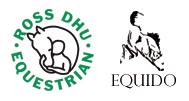At Ross Dhu Equestrian Centre we have extensive experience in travelling with our horses and our customers’ horses in trailers. However, during our many years of working with horses, we have heard some shocking stories of horses being badly hurt or sadly killed from lack of or poor travel preparations. Horses involved in trailer accidents, could easily be avoided if the proper safety measures are adhered too. Please see below the Ross Dhu Equestrian Centre drivers guide to travelling safely below.
- Training to load – training a horse to load takes patience and preparation. Never leave it until the last minute and never suddenly decide to load a horse when you are in a hurry and short of time. It can be quite unnerving for a horse to walk on a ramp and into a small space.
- Adequate vehicle towing power – the vehicle you use to tow the horse trailer must be suitable for the weight of the trailer once your horse is loaded. If you’re unsure, double check.
- Vehicle safety check – again, double check that the brakes are working, including the emergency brakes, that all the tyres are correctly balanced and that the trailer electrics are working correctly.
- Sufficient space – the options for transporting your horse are horse facing forwards, backwards, or on a slant. Whichever you choose, ensure that there is sufficient (but not too much) space for your horse, allowing it to brace around corners and when braking. Too much room can allow the horse to fall over during travelling and be far more tiring.
- Light and airy – allowing your horse plenty of headroom, and allowing him to stand straight within the space.
- Ramp condition – ensure that your ramp is in good condition and ideally has a rubber or matting surface. The ramp angle should be as shallow as possible, without too great a step for your horse onto the ramp.
- Partition – ideally padded partitions are too be used, however the most important thing it to make sure that these are secured and cannot be knocked out of place by your horse.
- Flooring – use non-slip rubber floor, that has a coating of straw or something similar covering it.
- Breast bar – make sure that this is at the correct height for your horse.
- Travel clothing – Horses should wear protective travel clothing i.e. good leather head collar that fits correctly, leg protection, to protect them from injury and to ensure that they stay safe and comfortable during loading and the journey itself.
Most importantly the driver may need to adapt their normal car-driving style, to consider the ride for the horse – how and when you brake is entirely different when carrying a live load, as are considerations of cornering, stopping and accelerating. We always say it is better to plan ahead and give yourself plenty of time to travel with a horse, so that all arrive fresh and relaxed after the journey.
For more information please feel free to call Morag on 01698 886 492 or email on contact@scottishhorsehelp.com.
